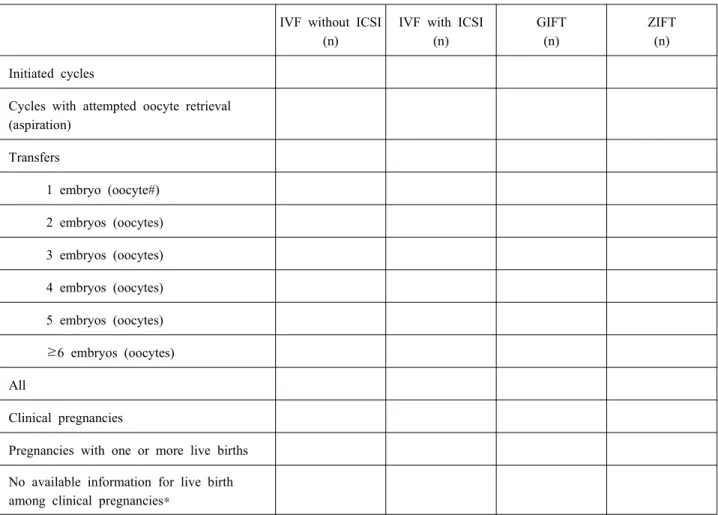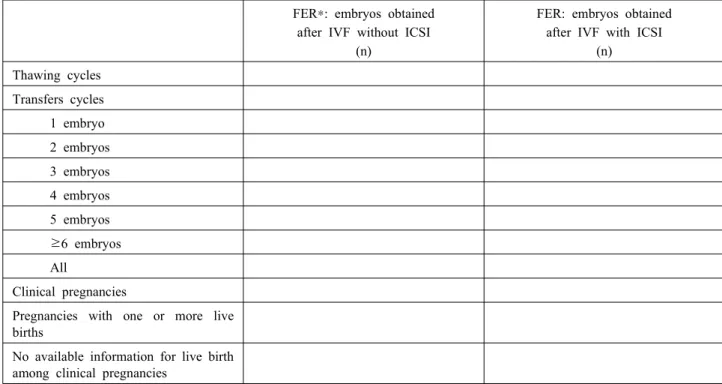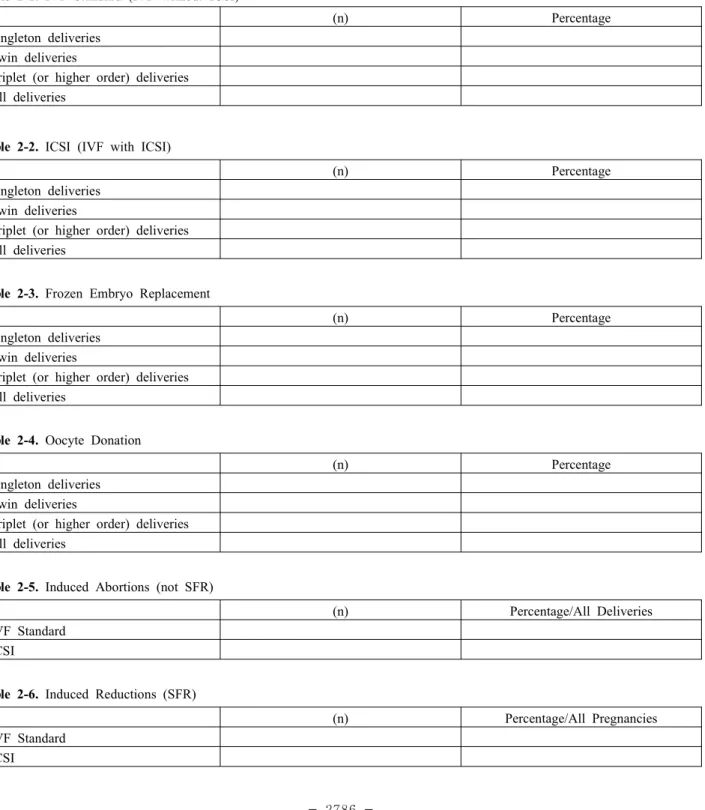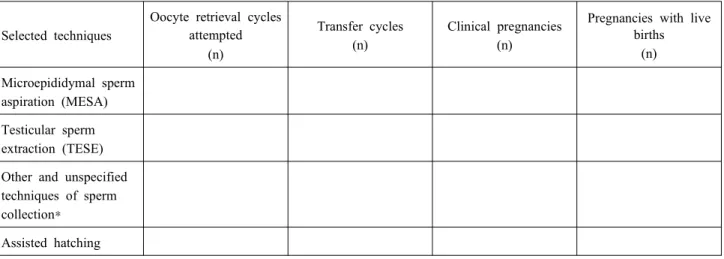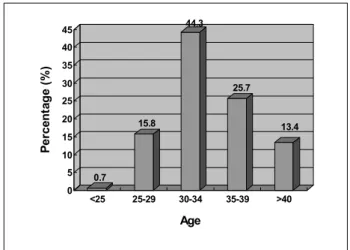제 1 장 서 론
년 국내에서 체외수정시술에 의한 첫 시험관아기 1985
가 탄생한 이래 불임 환자 치료를 위한 보조생식술은 날 로 그 시술 기관과 시행수가 증가되고 있을 뿐만 아니 라 치료성적도 괄목할 만큼 개선되는 등 불임증 진단과, 치료에 많은 발전이 있어 왔다 불임을 치료하기 위해. 보조생식술을 시행하고 있는 의료기관으로부터의 자료 는 성공적인 보조생식술 즉 생아의 출산을 가능하게 하, 는 여러 가지 요소들에 대한 풍부하고 귀중한 자료가 될 수 있다 각 의료기관별의 치료 성적은 그 자체로도 의. 미가 있지만 성공률과 성공에 영향을 주는 요소에 대한 통합적인 분석을 위해서는 국내의 여러 의료기관으로부 터의 자료를 취합하여 국내 통계를 구해보는 것이 의미 가 있을 것이며 이러한 조사는 국내 불임 환자 및 보조, 생식술 시술 기관의 실태 파악에 도움을 주는 것은 물론 궁극적으로 국내 보조생식술에 관한 전체적이고 일관성 있는 자료를 장기적으로 처리 분석하여 불임증 치료의
방향까지 제시할 수 있을 것으로 기대된다.
년 월 제정된 인공수태 윤리에 관한 선언에 의 1993 5
하면 인준된 인공수태시술 의료기관은 그 시술내용을, 연 회 이상 대한의사협회 또는 동 협회가 지정한 관련1 ( 학회 에 보고하도록 되어 있으며) , 1994년 본 학회 내에 인공수태시술 의료기관 심사소위원회가 설치되었다 대. 한산부인과학회에서는 1992년부터 국내 보조생식술의 현황을 조사하여 보고하여 오고 있고2005 10년 월 현재 개의 의료기관이 인공수태시술 의료기관으로 인준되 92
어 있다 이러한 조사사업의 일환으로. 2002년도 보조생 식술 현황도 조사하여 이에 보고하게 되었다.
본 조사에 의해 얻어진 국내 보조생식술에 대한 자료 는 불임 환자 및 보조생식술 시술 기관의 실태파악에 도 움을 주는 것은 물론 더 나아가서는 시술방법의 계속적 인 개선과 발전 부작용의 감소와 임신 성공률의 향상을, 도모하는데 유용한 자료로 활용될 것이다 본 조사 연구. 는 대한산부인과학회의 재정 지원 하에 수행되었으며, 실무에서 많은 노력을 기울인 대한산부인과학회의 직원 여러분들과 서울대학교병원의 김진주 선생 이동옥 선, 생 그리고 본 조사에 협조하여 주신 국내 각 인공수태시 술의료기관의 여러분들께 본 심사소위원회에서는 깊은
접수일 2005. 10. 27.: 주관책임자:최영민 E-mail: ymchoi@snu.ac.kr
조사보고서
한국 보조생식술의 현황 : 2002 년
대한산부인과학회
인공수태시술 의료기관 심사소위원회
Current Status of Assisted Reproductive Current Status of Assisted Reproductive Current Status of Assisted Reproductive Current Status of Assisted Reproductive
Technology in Korea, 2002
Technology in Korea, 2002
Technology in Korea, 2002
Technology in Korea, 2002
년 월 2005 10 대한산부인과학회 인공수태시술의료기관 심사소위원회 위원장 윤태기 포천중문의대( )
간 사 최영민 서울의대( ) 위 원 김선행 고려의대( )
강인수 성균관의대( ) 김정훈 울산의대( ) 노성일 미즈메디병원( ) 류철희 전북의대( ) 문신용 서울의대( ) 문화숙 문화병원( ) 민응기 함춘클리닉( ) 이규섭 부산의대( ) 이병석 연세의대( ) 이상훈 중앙의대( ) 이여일 전남의대( ) 이원돈 마리아병원( ) 이정호 계명의대( ) 전상식 경북의대( ) 한혁동 연세의대( )
이상 가나다순
( )
제 2 장 조사대상 및 방법
조사대상 1.
본 연구의 목적은2002 1 1년 월 일부터2002 12년 월 일까지 국내에서 시술된 보조생식술의 현황 및 시술 31
성적을 파악하고자 하는 것이다 조사 시점인. 2004 7년 월 당시 대한산부인과학회에 인공수태시술 의료기관으 로 인준되어 있는 개의 의료기관을 대상으로 설문지92 를 발송하였으며(Fig. 1),이들 기관 중 시술 성적을 보 고한 개의 의료기관 중 시술례가 있는 개 기관의73 69 결과를 종합하여 분석하였다 본 연구조사 결과 분석에.
던 기관 년간 시행하는 총 치료주기의 수에 따라 의료) 1 기관을 분류해 보면Table 1과 같다.
가천의대 중앙길병원 인천
1. *,
강산부인과 수원
2. *,
건양대학교병원 대전
3. *,
경북대학교 병원 대구
4. *,
경상대학교 병원 진주
5. *,
경희의대 경희의료원 서울
6. *,
계명대학교 동산의료원 대구
7. *,
고려대학교 안암병원 서울
8. *,
광주기독병원 광주
9. *,
단국대학병원 천안
10. *,
대구여성차병원 대구
11. *,
동국의대 경주병원 경주
12. *,
동래현대병원 부산
13. *,
동아대학병원 동아의료원 부산
14. *,
마리아병원 서울
15. *,
마리아의원 광주
16. *,
마리아의원 대구
17. *,
마리아의원 대전
18. *,
마리아의원 부산
19. *,
마리아의원 인천
20. *,
마산삼성병원 마산
21. *,
마산순안병원 마산
22. *,
목병원 서울 23. *,
미래와희망 산부인과 서울
24. *,
미즈메디병원 강남 서울
25. ( ) *,
박금자산부인과 서울
26. *,
부산대학교 병원 부산
27. *,
분당서울대학교병원 분당
28. ,
서울대학교병원 서울
29. *,
서울예일산부인과 서울
30. *,
성균관의대 삼성서울병원 서울
31. *,
성균관의대 삼성제일병원 서울
32. *,
세화병원 부산 33. *,
신산부인과병원 경기
34. ,
아름병원 부산 35. *,
에덴산부인과 익산
36. *,
엘르메디 구 조재동산부인과 창원
37. ( ) *,
연세대학교 원주의과대학 원주기독병원 원주
38. *,
연세대학교 신촌세브란스병원 서울
39. *,
울산대학교 서울아산병원 서울
40. *,
Table 1. Number of IVF centers according to size (total number of treatment cycles in the year)
Number of treatment cycles started in year Number of IVF centers
1,000 or more 5
500-999 4
200-499 10
100-199 6
Less than 100 44
Number of IVF centers providing data for this report 69
Total number of IVF centers 92
은병원 광주 41. *,
을지병원 서울 42. *,
이도근산부인과 진주
43. *,
이두룡산부인과 대구
44. *,
이화의대부속 목동병원 서울
45. *,
인정병원 서울
46. ,
인제의대부속 상계백병원 서울
47. *,
인제의대부속 서울백병원 서울
48. *,
일신기독병원 부산
49. *,
장스여성병원 서울
50. *,
전남대학교병원 광주
51. *,
전북대학교병원 전주
52. *,
전주 문산부인과 전주
53. *,
제일산부인과 익산
54. *,
제주차산부인과의원 제주
55. *,
조선대학병원 광주
56. *,
조영열 산부인과 구리
57. *,
중앙의대부속 필동병원 서울
58. *,
좋은문화병원 부산
59. *,
창원한마음병원 창원
60. *,
청담마리산부인과 서울
61. *,
청주이화산부인과 청주
62. *,
충남대학교 병원 대전
63. *,
포천중문의과대학 분당차병원 분당
64. *,
포천중문의과대학 차병원 서울
65. *,
프리모산부인과 청주
67. *,
하나병원 대구 68. *,
한나여성의원 서울
69. *,
한라병원 제주 70. *,
한림의대부속 강동성심병원 서울
71. *,
함춘여성크리닉 서울
72. *,
홍 산부인과 대전
73. ,
가나다순
( )
조사설문지를 대상 기관에 e-mail로 발송하였으며, 로 설문지를 회수하였다 발송된 설문지는 다음
e-mail .
과 같다.
년도 보조생식술 시술결과 보고서 2002
REGISTRATION FORM OF ASSISTED REPRODUCTION: 2002 REGISTRATION FORM OF ASSISTED REPRODUCTION: 2002 REGISTRATION FORM OF ASSISTED REPRODUCTION: 2002 REGISTRATION FORM OF ASSISTED REPRODUCTION: 2002
PLEASE READ INSTRUCTIONS AND FOOTNOTES CAREFULLY BEFORE PLEASE READ INSTRUCTIONS AND FOOTNOTES CAREFULLY BEFORE PLEASE READ INSTRUCTIONS AND FOOTNOTES CAREFULLY BEFORE PLEASE READ INSTRUCTIONS AND FOOTNOTES CAREFULLY BEFORE
COMPLETING THE FORMS COMPLETING THE FORMS COMPLETING THE FORMS COMPLETING THE FORMS
Name of IVF Center (한글) Contact Person
Name (한글) Tel Fax
Address (한글)
All data relate to treatment cycles that were started during the calendar year, 2002, and to any clinical pregnancies resulting from those treatment cycles. Please complete as many data items as possible (n=number). If data are not available for some items, write NA. Gestational age (duration of pregnancy) should be calculated by adding 14 days (2 weeks) to the number of completed weeks between the date of fertilization (conception) and the date of completion of the pregnancy
In the following tables :
Standard IVF (IVF without ICSI) Standard IVF (IVF without ICSI)Standard IVF (IVF without ICSI)
Standard IVF (IVF without ICSI) includes those treatment cycles and pregnancies in which fertilization occurred, or was intended to occur, in the laboratory and fresh embryos were transferred to the uterus or fallopian tubes. This heading excludes: (1) frozen/thawed embryo transfer cycles; and (2)This heading excludes: (1) frozen/thawed embryo transfer cycles; and (2)This heading excludes: (1) frozen/thawed embryo transfer cycles; and (2)This heading excludes: (1) frozen/thawed embryo transfer cycles; and (2) microinsemination techniques.
microinsemination techniques.microinsemination techniques.
microinsemination techniques.
ICSIICSIICSI
ICSI includes those treatment cycles and pregnancies that follow transfer of fresh embryos after intracytoplasmic sperm injection. Transfer cycles after both ICSI and embryo freezing are recorded separatedly.
GIFT includes only those cycles and pregnancies in which gametes (oocytes and sperm) were transferred to the fallopian tubes (excluding combined IVF and GIFT in the same cycle, which should be recorded in IVF category).
주의:본 보고서에서ART procedure를 1) Standard IVF (IVF without ICSI), 2) ICSI, 3) GIFT, 4) FER (Frozen Embryo 의 가지로 구분하고 있습니다 그리고 Replacement) after standard IVF, 5) FER after ICSI, 6) Oocyte donation,7) ZIFT 7 . 이 항목들의 대상은 상호 중첩되지 않으니 숫자 기입시 유의하시기 바랍니다.
If you did not perform ART practice in 2002, check here. Not done If you performed ART practice in 2002, please fill out tables below.
Module Ia Module Ia Module Ia Module Ia
Pregnancy Outcomes in relation to Treatment Pregnancy Outcomes in relation to Treatment Pregnancy Outcomes in relation to Treatment Pregnancy Outcomes in relation to Treatment
Table 1a-1. Pregnancy outcomes: IVF, ICSI, GIFT, ZIFT IVF without ICSI
(n)
IVF with ICSI (n)
GIFT (n)
ZIFT (n) Initiated cycles
Cycles with attempted oocyte retrieval (aspiration)
Transfers
1 embryo (oocyte#) 2 embryos (oocytes) 3 embryos (oocytes) 4 embryos (oocytes) 5 embryos (oocytes) 6 embryos (oocytes)
≥ All
Clinical pregnancies
Pregnancies with one or more live births No available information for live birth among clinical pregnancies*
This table excludes cycles in which frozen/thawed embryos were transferred.
∙
#: in case of GIFT
Clinical pregnancy : Presence of an intrauterine gestational sac on ultrasound examination
*임신한 환자중 live birth 여부가 확인되진 못한 환자들의 수.
Table 1a-2. Pregnancy outcomes after transfer of frozen/thawed embryos FER*: embryos obtained
after IVF without ICSI (n)
FER: embryos obtained after IVF with ICSI
(n) Thawing cycles
Transfers cycles 1 embryo 2 embryos 3 embryos 4 embryos 5 embryos 6 embryos
≥ All
Clinical pregnancies
Pregnancies with one or more live births
No available information for live birth among clinical pregnancies
*FER (Frozen Embryos Replacement)
Table 1a-3. Pregnancy outcomes after oocyte donation
(n) Cycle Donation
Transfers 1 embryo 2 embryos 3 embryos 4 embryos 5 embryos 6 embryos
≥ All
Clinical pregnancies
Pregnancies with one or more live births
No available information for live birth among clinical pregnancies
Module Ib Module Ib Module Ib Module Ib
Women's Age and Indications for IVF Treatment Women's Age and Indications for IVF Treatment Women's Age and Indications for IVF Treatment Women's Age and Indications for IVF Treatment
기준 기준 기준 기준 AGE at start of Treatment (Initiated cycle ) AGE at start of Treatment (Initiated cycle ) AGE at start of Treatment (Initiated cycle ) AGE at start of Treatment (Initiated cycle )
Table Ib-1. STANDARD IVF TREATMENT (excluding ICSI, FER, Donation cycles)
(n) Age of female <25
Age of female 25-29 Age of female 30-34 Age of female 35-39 Age of female ≥40
Table Ib-2. ICSI TREATMENT (excluding STANDARD IVF, FER, Donation cycles)
(n) Age of female <25
Age of female 25-29 Age of female 30-34 Age of female 35-39 Age of female ≥40
Table 1b-3. OOCYTE DONATION: Recipient cycles
(n) Age of female <25
Age of female 25-29 Age of female 30-34 Age of female 35-39 Age of female 40-44 Age of female ≥45
INDICATIONS (excluding FER/Donation) INDICATIONS (excluding FER/Donation) INDICATIONS (excluding FER/Donation) INDICATIONS (excluding FER/Donation)
Table 1b-4. Indications
INDICATIONS FOR ART IVF without ICSI (n) IVF with ICSI (n)
Female only Male factor only Mixed male and female Unexplained
Other factors
ART Report Forms, Korea 2002 ART Report Forms, Korea 2002 ART Report Forms, Korea 2002 ART Report Forms, Korea 2002
Module Ic Module Ic Module Ic Module Ic
Complications of Treatment Complications of Treatment Complications of Treatment Complications of Treatment
Table 1c. Complications that require admission to hospital
Complications (n)
Hyperstimulation syndrome Complications of oocyte retrieval
Bleeding Infection All Maternal deaths related to the ART process
Maternal deaths related to the pregnancy itself
Module 2 Module 2 Module 2 Module 2
Deliveries in relation to Treatment Deliveries in relation to Treatment Deliveries in relation to Treatment Deliveries in relation to Treatment
Table 2-1. IVF Standard (IVF without ICSI)
(n) Percentage
Singleton deliveries Twin deliveries
Triplet (or higher order) deliveries All deliveries
Table 2-2. ICSI (IVF with ICSI)
(n) Percentage
Singleton deliveries Twin deliveries
Triplet (or higher order) deliveries All deliveries
Table 2-3. Frozen Embryo Replacement
(n) Percentage
Singleton deliveries Twin deliveries
Triplet (or higher order) deliveries All deliveries
Table 2-4. Oocyte Donation
(n) Percentage
Singleton deliveries Twin deliveries
Triplet (or higher order) deliveries All deliveries
Table 2-5. Induced Abortions (not SFR)
(n) Percentage/All Deliveries
IVF Standard ICSI
Table 2-6. Induced Reductions (SFR)
(n) Percentage/All Pregnancies
IVF Standard ICSI
ART Report Forms, Korea 2002 ART Report Forms, Korea 2002 ART Report Forms, Korea 2002 ART Report Forms, Korea 2002
Module 3a Module 3a Module 3a Module 3a
Perinatal Mortality in relation to Treatment and Multiple Deliveries Perinatal Mortality in relation to Treatment and Multiple Deliveries Perinatal Mortality in relation to Treatment and Multiple Deliveries Perinatal Mortality in relation to Treatment and Multiple Deliveries
Table 3a-1. IVF without ICSI (Not deliveries, but Baby No.)
All babies (n) Stillborn (n) Early neonatal death (n) Singleton
Twin Triplet All babies
Table 3a-2. ICSI (IVF with ICSI) (Not deliveries, but Baby No.)
All babies (n) Stillborn (n) Early neonatal death (n) Singleton
Twin Triplet All babies
Table 3a-3. FER (Frozen Embryo Replacement) (Not deliveries, but Baby No.)
All babies (n) Stillborn (n) Early neonatal death (n) Singleton
Twin Triplet All babies
Table 3a-4. Oocyte Donation (Not deliveries, but Baby No.)
All babies (n) Stillborn (n) Early neonatal death (n) Singleton
Twin Triplet All babies
- Deliveries include all with a gestational age at > 20 weeks from the calculated last menstrual period.
- An early neonatal death is defined as a death occurring within the first week postpartum.
- Stillborn include deaths occurring during the delivery process.
Module 3b Module 3b Module 3b Module 3b
Malformations in relation to Treatment Malformations in relation to Treatment Malformations in relation to Treatment Malformations in relation to Treatment (includes chromosomal abnormalities) (includes chromosomal abnormalities) (includes chromosomal abnormalities) (includes chromosomal abnormalities)
Table 3b-1. Standard IVF (IVF without ICSI)
(n) Total number of infants (live-born and stillborn)
Number of malformations
Terminations because of a malformed fetus (excluding the malformations in the above line)
Table 3b-2. ICSI (IVF without ICSI)
(n) Total number of infants (live-born and stillborn)
Number of malformations
Terminations because of a malformed fetus (excluding the malformations in the above line)
Table 3b-3. FER (Frozen Embryo Replacement)
(n) Total number of infants (live-born and stillborn)
Number of malformations
Terminations because of a malformed fetus (excluding the malformations in the above line)
Table 3b-4. Oocyte Donation
(n) Total number of infants (live-born and stillborn)
Number of malformations
Terminations because of a malformed fetus (excluding the malformations in the above line)
Please list malformations which were reported, if available:
ART Report Forms, Korea 2002 ART Report Forms, Korea 2002 ART Report Forms, Korea 2002 ART Report Forms, Korea 2002
Module 4 Module 4 Module 4 Module 4
Clinical Outcomes by Maternal Age, Cause of Infertility Clinical Outcomes by Maternal Age, Cause of Infertility Clinical Outcomes by Maternal Age, Cause of Infertility Clinical Outcomes by Maternal Age, Cause of Infertility
Table 4-1. Number of oocyte “retrieval cycles” and clinical pregnancies by maternal age
Standard IVF* IVF with ICSI GIFT
Women‘s age at start of treatment
Oocyte retrieval# (n)
Clinical pregnancies (n)
Oocyte retrieval (n)
Clinical pregnancies (n)
Oocyte retrieval (n)
Clinical pregnancies (n)
<25 years 25-29 30-34 35-39
>40
*IVF without ICSI
# Oocyte retrieval cycles attempted
Table 4-2. Number of oocyte “retrieval cycles” and clinical pregnancies by cause(s) of infertility
Standard IVF IVF with ICSI GIFT
Cause(s) of infertility Oocyte retrieval* (n)
Clinical pregnancies (n)
Oocyte retrieval* (n)
Clinical pregnancies (n)
Oocyte retrieval (n)
Clinical pregnancies (n) Female only
Male factor only Mixed male and
female Unexplained Other factors
* Oocyte retrieval cycles attempted
- This table excludes cycles using frozen/thawed embryos.
- The groups in the sections on cause of infertility are mutually exclusive so each treatment cycle or pregnancy should be included in only one group.
Table 4-3. Number of oocyte “retrieval cycles” and clinical pregnancies by number of embryos or oocytes transferred
Standard IVF IVF with ICSI GIFT
Number of embryos /oocytes transferred
Transfer cycles*
(n)
Clinical pregnancies (n)
Transfer cycles*
(n)
Clinical pregnancies (n)
Transfer cycles*
(n)
Clinical pregnancies (n) One
Two Three
Four Five Six or more
- This table excludes cycles using frozen/thawed embryos.
Module 5 Module 5 Module 5 Module 5
Embryo Freezing and Other Special Techniques Embryo Freezing and Other Special Techniques Embryo Freezing and Other Special Techniques Embryo Freezing and Other Special Techniques
Table 5-1. Embryo freezing
Have you ever performed embryo freezing in 2002? Yes ( ), No ( )
(n) Number of oocyte pick-up (OPU) cycles that resulted in embryo freezing in 2002
Number of embryos that were frozen in 2002
Total number of embryos in frozen storage at present (조사시점)
Table 5-2. Oocyte retrieval cycles, transfer cycles and pregnancies using special techniques of sperm collection and/or assisted hatching
Selected techniques
Oocyte retrieval cycles attempted
(n)
Transfer cycles (n)
Clinical pregnancies (n)
Pregnancies with live births
(n) Microepididymal sperm
aspiration (MESA) Testicular sperm extraction (TESE) Other and unspecified techniques of sperm collection*
Assisted hatching
*: describe:
* 이상입니다 기입하여 주셔서 감사드립니다. .
본 조사에서는 체외수정 및 자궁내 배아이식술 (in vitro fertilization and embryo transfer: IVF-ET) 중 난자세포질내 정자주입술 (intracytoplasmic sperm 을 시행한 경우를 분리하여 조사하였으 injection: ICSI)
며 마찬가지로 냉동보존배아를 이용한IVF-ET의 경우 에도ICSI를 시행한 군과 시행하지 않은 군으로 나누어 보고하게 하였다.
모든 자료들은 2002년에 시작된 치료주기에 관련된 것이고 따라서2002년에 시작된 주기의 결과로 발생한 임상적 임신은 모두 분석에 포함하였다 임상적 임신은. 초음파에 의한 태낭의 확인 또는 소파술로 얻어진 임 신 산물 등의 임신의 임상적 증후가 있는 경우만을 포 함하고 단순히 혈중 -hCG만의 상승이 있었던 생화 학적 임신은 제외하였다 임신 주수는 수정으로부터. 임신이 종결된 시점간의 기간에 일 주 을 더하여14 (2 )
의 수로 나타내었다 completed weeks .
그리고 취합된 자료들은 Microsoft사의Excel프로그 램을 이용하여 분석하였다.
제 3 장 결과 분석 및 고찰
년도 한국 보조생식술 시술 개요 1. 2002
년의 시술례를 보고해 온 국내의 개의 보조생
2002 69
식술 시술기관에서 총18,310예의 보조생식술을 시행 하였다(Table 2). 이는2000 58년 개의 시술기관에서 예 년 개의 보조생식술 시술기관에서 총 15,619 , 2001 53
예를 보고한 것과 비교하여 증가한 숫자이다
14,667 .
보조생식술의 시술 방법별 분포를 보면 총, 18,310예 의 주기 중IVF (ICSI를 병행한 경우는 제외) 9,292예
예 로 와 시술의
(50.7%), ICSI 6,704 (36.6%) IVF ICSI 합이 총15,996 (87.4%)예 로 대부분의 보조생식술이 신선 배아를 이용하는 것으로 이루어지고 있음을 알 수 있다 냉동보존 배아이식. (cryopreserved embryo
은 예 가 시
transfer: cryopreserved ET) 1,989 (10.9%) 행되었으며 난자 공여시술, (oocyte donation) 314은 예 (1.7%), 생식세포 난관내이식술 (gamete intraf-
은 예 접합자 난관
allopian transfer: GIFT) 2 (0.01%),
내이식술 (zygote intrafallopian transfer: ZIFT) 9은 예 (0.05%)였다(Table 2, Fig. 2).
5 0 .7 % 3 6 .6 %
0 .1 %
1 0 .9 % 1 .7 %
IV F -E T IV F -E T IV F -E T IV F -E T IC S I IC S I IC S I IC S I G IF T , Z IF T G IF T , Z IF T G IF T , Z IF T G IF T , Z IF T F E R F E R F E R F E R O DO D O DO D
Fig. 2. Types of ART procedures.
와 2. IVF ICSI
임상적 임신율 및 생아 출생률 1)
와 를 시행받은 대상 환자 중 총 명 난
IVF ICSI 4,792 (
자 채취 주기당31.7%,배아 이식 주기 당33.5%)이 임 상적으로 임신을 확인할 수 있었으며 추정하여, 3,812 명 난자 채취 주기당( 25.2%, 배아 이식 주기 당
이 생아를 출산하였다
26.7%) (Table 2).
0.7 15.8
44.3
25.7
13.4
0 5 10 15 20 25 30 35 40 45
Percentage (%)
<25 25-29 30-34 35-39 >40
Age
Fig. 3. Percentage of ART users by ages: IVF & ICSI.
대상 환자의 연령분포 및 이에 따른 임신율 2)
와 를 시행 받은 대상 환자의 연령분포를 보 IVF ICSI
세가 세 이상이 로 44.3%, 35-39 25.7%, 40 13.4% 30-
세가 전체의 로 대부분을 차지하였다
39 70.0% (Table
3, Fig. 3).
난자 채취 주기 당 임상적 임신율은 25세 미만이
세가 세가
47.7%, 25-29 41.4%, 30-34 36.0%, 35-39 세가27.3%, 40세 이상은13.6%로 나이가 증가할수록 임신율이 감소하였다 (
p
<0.001) (Table 3, Fig. 4).47.7 41.4
36
27.3
13.6
0 5 10 15 20 25 30 35 40 45 50
CP/Retrieval(%)
<25 25-29 30-34 35-39 >40
Age
Fig. 4. Clinical pregnancy rates by ages of women IVF & ICSI.
불임 원인 및 이에 따른 임신율 3)
와 를 시행 받은 대상 환자의 적응증 즉 불
IVF ICSI ,
임증의 원인 인자별 분포는 여성 인자(female only)만 있는 경우가43.9%, 남성 인자(male factors only)만 있는 경우가19.9%,여성 인자와 남성 인자가 공존하는 경우(mixed male and female) 11.9%,가 원인불명의 불임증 (unexplained)이 17.4%, 기타 다른 인자가
이었다
6.9% (Table 4, Fig. 5).
4 3 .9 %
1 9 .9 % 1 1 .9 %
1 7 .4 % 6 .9 %
F e m a l e o n l y F e m a l e o n l yF e m a l e o n l y F e m a l e o n l y M a l e o n ly M a l e o n lyM a l e o n ly M a l e o n ly M ix e d M ix e dM ix e d M ix e d U n e x p la in e d U n e x p la in e dU n e x p la in e d U n e x p la in e d O t h e r f a c t o r s O t h e r f a c t o r sO t h e r f a c t o r s O t h e r f a c t o r s
Fig. 5. Primary diagnosis for ART procedures.
난자 채취 주기 당 임상적 임신율은 여성 인자만 있는 경우는33.5%, 남성 인자만 있는 경우는 44.3%, 여성 인자와 남성 인자가 공존하는 경우는30.8%, 원인불명 의 불임증은33.0%, 기타 다른 인자의 경우 28.3%로 원인별로 유의하게 차이가 있었다 (
p
<0.001) (Table 4, Fig. 6).33.5%
44.3%
30.8%
33.0%
28.3%
0 1 0 2 0 30 4 0 5 0
F e m a le o n ly M a le o n ly M ixe d U n e x p lain e d O th e r fa c to r
Fig. 6. Clinical pregnancy rates by cause of infertility.
Table 2. Clinical pregnancy in relation to treatment
Treatment cycles / IVF ICSI ZIFT GIFT FER* after FER after Oocyte
pregnancies IVF ICSI donation
Cycles initiated (started)# 9292 6704 9 2 1173 816 -
Cycles with oocyte retrieval 8593 6528 9 2 - - 314
Cycles with embryo transfer 8058 6235 8 2 1107 759 286
1 embryo (oocyte$) 602 715 1 1 111 68 8
2 embryo (oocytes) 1139 895 1 0 238 159 23
3 embryo (oocytes) 1915 1315 2 1 320 212 50
4 embryo (oocytes) 2763 1973 1 0 189 158 101
5 embryo (oocytes) 1285 1001 1 0 134 83 71
6 embryo (oocytes)
≥ 354 337 2 0 115 79 33
Clinical pregnancies 2789 2003 2 0 303 227 150
(CP per retrieval, %) 32.5% 30.7% 22.2% 47.8%
(CP per transfer, %) 34.6% 32.1% 25.0% 27.4% 29.9% 52.4%
Live births# 2232 1580 2 228 186 125
(Live births per retrieval, %) 26.0% 24.2% 22.2% - - 39.8%
(Live births per transfer, %) 27.7% 25.3% 25.0% 20.6% 24.5% 43.7%
*: frozen embryos replacement
$: in case of GIFT, #: estimated
Table 3. Number of oocyte retrieval cycles and clinical pregnancies by maternal age Maternal age at start
of treatment
IVF ICSI Total
OR cycles CP (%) OR cycles CP (%) OR cycles CP (%)
<25 51 21 (41.2%) 58 31 (53.4%) 109 52 (47.7%)
25-29 1411 565 (40.0%) 978 424 (43.4%) 2389 989 (41.4%)
30-34 3917 1445 (36.9%) 2785 969 (34.8%) 6702 2414 (36.0%)
35-39 2218 612 (27.6%) 1671 449 (26.9%) 3889 1061 (27.3%)
>40 996 146 (14.7%) 1036 130 (12.5%) 2032 276 (13.6%)
Total 8593 2789 (32.5%) 6528 2003 (30.7%) 15121 4792 (31.7%)
Table 4. Number of oocyte retrieval cycles by cause of infertility
Cause of infertility IVF ICSI Total
OR cycles CP (%) OR cycles CP (%) OR cycles CP (%)
Female only 4446 1609 (36.2%) 1541 399 (25.9%) 5987 2008 (33.5%)
Male factor only 265 130 (49.1%) 2442 1070 (43.8%) 2707 1200 (44.3%)
Mixed male and female 659 241 (36.6%) 969 261 (26.9%) 1628 502 (30.8%)
Unexplained 1508 591 (39.2%) 856 190 (22.2%) 2364 781 (33.0%)
Other factors 572 183 (32.0%) 367 83 (22.6%) 939 266 (28.3%)
Total 7450 2754 (37.0%) 6175 2003 (32.4%) 13625 4757 (34.9%)
경우가9.5%, 2개인 경우14.3%, 3개인 경우22.5%, 4 개인 경우32.8%, 5개인 경우16.2%, 6개 이상인 경우
였다
4.7% (Table 2).
이식 주기당 임상적 임신율은 이식한 배아의 수가 1 개의 경우는 10.6%, 2개인 경우 25.3%, 3개인 경우
개인 경우 개인 경우 개 이
36.1%, 4 37.9%, 5 38.0%, 6 상인 경우33.4%로 배아 이식 수에 따라 유의하게 다른 임신율을 보였다 (
p
<0.001) (Table 5).Table 5. Clinical pregnancies by number of embryos transferred
Standard IVF IVF with ICSI Total
Number of Clinical Transfer Clinical Transfer cycles Clinical
embryos Transfer cycles pregnancies (%) cycles pregnancies (%) pregnancies (%) transferred
One 600 73 (12.2%) 729 68 (9.3%) 1329 141 (10.6%)
Two 1113 300 (27.0%) 874 202 (23.1%) 1987 502 (25.3%)
Three 1877 717 (38.2%) 1252 412 (32.9%) 3129 1129 (36.1%)
Four 2683 1024 (38.2%) 1885 709 (37.6%) 4568 1733 (37.9%)
Five 1241 475 (38.3%) 1008 379 (37.6%) 2249 854 (38.0%)
Six or more 331 107 (32.3%) 328 113 (34.5%) 659 220 (33.4%)
Total 7845 2696 (34.4%) 6076 1883 (31.0%) 13921 4579 (32.9%)
Table 6. Deliveries in relation to treatment
Singleton Twin deliveries Triplet deliveries All deliveries IVF
Number (n) 766 336 5 1107
Percentage (69.2%) (30.4%) (0.5%)
ICSI
Number (n) 783 366 0 1149
Percentage (68.1%) (31.9%) (0%)
FER
Number (n) 216 46 0 262
Percentage (82.4%) (17.6%) (0%)
Oocyte donation
Number (n) 48 32 0 80
Percentage (60.0%) (40.0%) (0%)
와 시행주기에서 출생한 총 생아
IVF ICSI (live
중 단태아의 비율은 였으며 쌍태아
birth) 69.8% 는
삼태아는 였으며 사태아 이상은 없었다
30.0%, 0.2% .
전체적으로 쌍태아 이상의 다태 임신의 빈도가 일반 인 구에서의 쌍태아 빈도가 3% (Cunningham FG et al., Williams Obstetrics 21th ed. U.S.: McGrawHill 인 것과 비교하면 매우 높은 빈도이 Companies; 2001)
다 (Table 6, Fig. 7).
69.8%
30.0%
0.2%
Singleto n Singleto n Singleto n Singleto n TwinTwin TwinTwin Triplet Triplet Triplet Triplet
Fig. 7. Pluralities among live births: IVF & ICSI.
난자 공여시술
3. (oocyte donation)
총314예의 난자 공여시술이 있었으며, 286명에서 배 아이식을 시행하였다 배아 이식 당 임상적 임신율은.
생아 출산율은 였다
52.4%, 43.7% (Table 2).
생식세포 난관내이식술 4.
총 예에서 생식세포 난관내 이식을 시행하였으며2 , 생식세포 이식 주기 당 임상적 임신율은0%였다(Table 이는 년의 총 예에서 생식세포 난관내 이식 2). 2001 63
을 시행하여 생식세포 이식 주기 당 임신율29.0%, 생 아 출산율22.6%에 비해 많이 감소한 수치이다 접합자. 난관내 이식(ZIFT)은 총 예가 시행되었으며 이식 주9
Table 7. Oocyte retrieval cycles, transfer cycles and pregnancies using special techniques of sperm collection and/or assisted hatching
Selected techniques Oocyte retrieval Transfer cycles Clinical Pregnancies with cycles attempted pregnancies (%#) live births (%#)
Microepididymal sperm 100 100 38 (38.0%) 31 (31.0%)
aspiration (MESA)
Testicular sperm extraction (TESE) 814 774 304 (37.4%) 236 (29.0%)
Other and unspecified techniques 42 41 11 (26.2%) 7 (16.7%)
of sperm collection
Assisted hatching 2676 2653 790 (29.5%) 619 (23.1%)
#: per oocyte retrieval cycle
기 당 임신율은 25.0%, 이식 주기 당 생아 출산율은 였다
25.0% (Table 2).
5. 냉동보존 배아이식 (transfer of cryopreserved embryo)
년에 총 예의 냉동보존배아 이식시도가 있 2002 1,989
었으며 이중 총, 1,866예에서 냉동보존배아 이식을 시 행하였다 배아 이식주기 당의 임상적 임신율은. 28.4%
생아 출산율은22.2%였다(Table 2).
이식한 배아의 수는 개의 경우가1 9.6%, 2개인 경우
개인 경우 개인 경우 개인
21.3%, 3 28.5%, 4 18.6%, 5 경우11.6%, 6개 이상인 경우10.4%였다 (Table 2).
수술적 방법에 의한 정자 채취와 보조 부화술 6.
년에 시행된
2002 MESA (microsurgical epididymal 는 총 예이고 난자 채취 주기당 sperm aspiration) 100
임신율은38.0%,난자채취주기당 생아 출생율은31.0%
였다. TESE (testicular sperm extraction) 814는 예에 서 시행되었고 난자채취주기당 임신율은37.4%였고 난 자채취주기당 생아 출생율은29.0%였다 보조부화술은. 예에서 시행되었고 난자채취 주기당 임신율은 2,676
난자채취 주기당 생아 출생율은 였다
29.5%, 23.1%
(Table 7).
년 한국의 보조생식술의 현황을 조사해 보았을 2002
때 보조생식술의 성적은 국외보고와 대부분의 항목에서 유의한 차이는 찾아볼 수 없었다 여러 가지의 요인들이. 보조생식술의 성공에 영향을 줄 수 있으나 가장 중요한 것은 여성의 나이라는 것은 본 조사에서도 보여주고 있 다 그밖에 영향을 주는 요인으로는 불임의 원인 이식. , 배아의 수 등이 포함된다 남성불임에 있어서는. ICSI시
임신율의 상승을 가져오게 되어 정자공여 이외의 대안 이 없었던 불임부부에게 희망을 줄 수 있게 되었다 냉. 동보존 배아이식은 보조생식술의 비용이나 부작용을 줄 이면서 난자채취주기당 임신율을 높일 수 있는 좋은 방 법으로 냉동 해동의 기술 조건의 발전은 냉동 보존 후/ , 배아 회생율을 증가시켜 보조생식술의 성공률의 향상을 가져올 수 있을 것이다.

